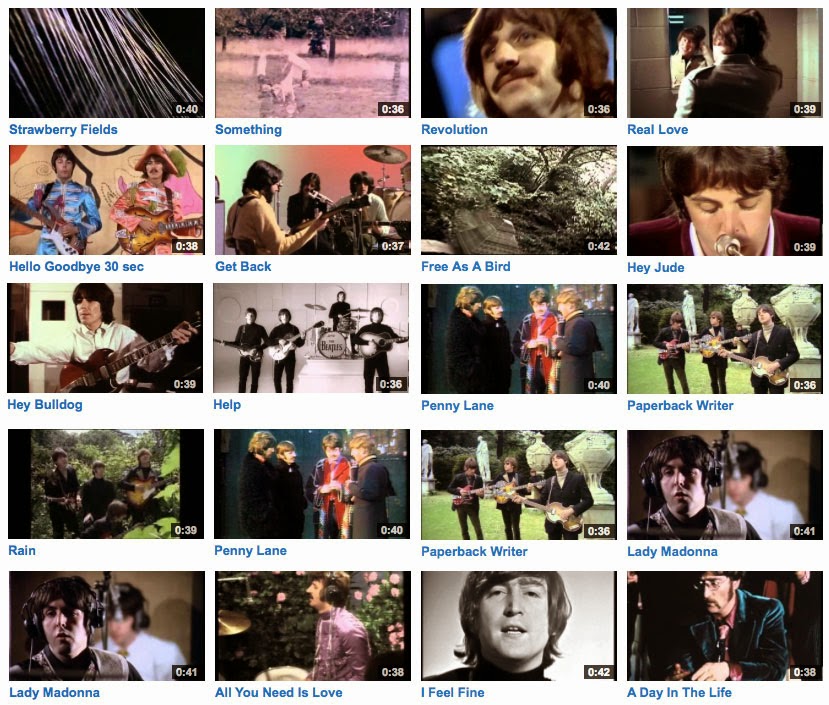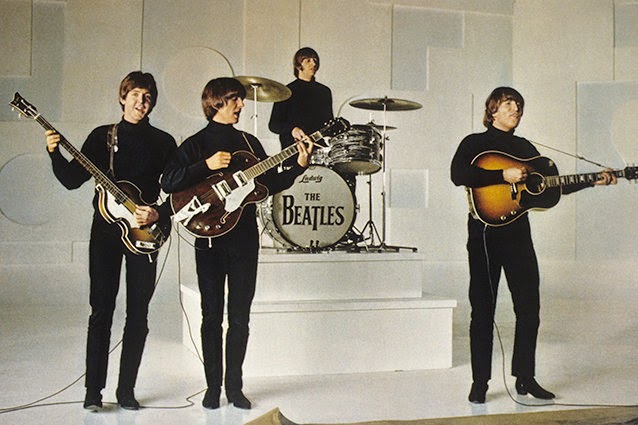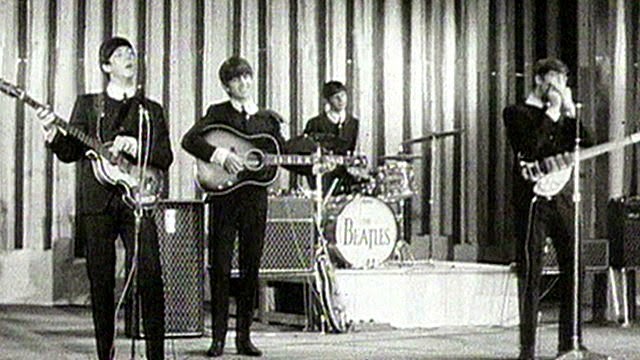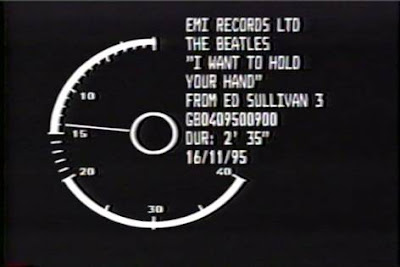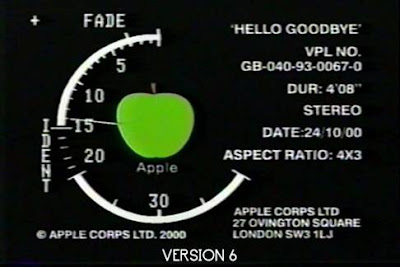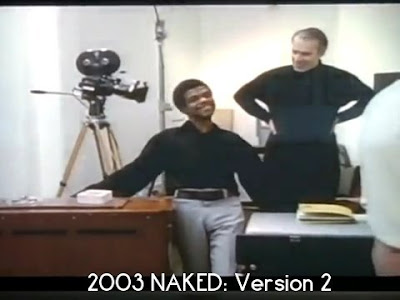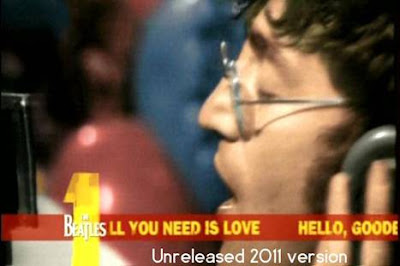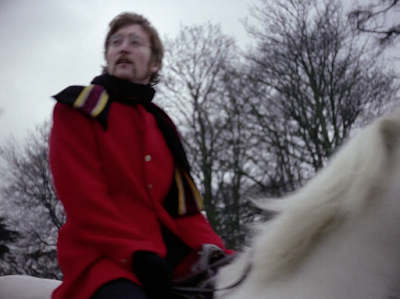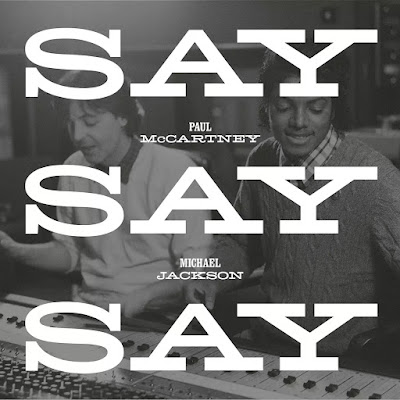As "A Day In The Life" was made available yesterday on
a Mashable page, sourced from Vevo, this clip was only available in the countries where Vevo works. Today it was published on The Beatles' Vevo YouTube channel as the window of exclusivity closed. Promoting
Beatles 1+![]()
, this is A Day In The Life as it looks now.
Miguel Carrera has sent us the following index of The Beatles' official music videos. While mostly of importance for video collectors, the list reveals that Apple has been working on promotional videos for a long time, and it also sheds light on an earlier attempt of making a "Beatles 1" compilation in 2011. In the following, I have used descriptions from
my own article on the subject from January 2015, and I have also changed Carrera's chronology.
THE BEATLES: The Original EMI, Capitol & Apple promo videos 1965-2015
Some videos were filmed a particular year, but remained unreleased at the time. Many appeared through the years until the Anthology project was released, or later. Indicated here: Year it was filmed but for the most part the year a clip became an official "music video". If the same version was used to promote different official releases over the years, the changing only of the slate and the closing credits with year of release is also included. All the variations over the years, available sometimes from the masters that Intertel/Apple/EMI created, or good to very good copies of them, with original VRT or clock ("w/slate") and with a few exceptions these are
not taken from TV or music channels.
Only
official videos are included here, no clips from TV shows, like "The Music of Lennon & McCartney", or concerts that have appeared over the years on bootlegs or fan made compilations like "Chronology", "By the Bushel", "Unsurpassed Promos", etc. Clips from the movies/concerts or TV shows are included only when they come with the original Apple VTR slate, which means it's an official video clip, and not a "fan-made compilation", extracting all songs from the movies to create "Lost Videos" compilations. Also, no
fakes here. If you can’t find a particular video that you may recall having seen, it was either taken directly from the movies or was a fake. Also, no "outtakes", or videos created from the outtakes (like "Rain", "Paperback Writer", "Strawberry Fields Forever", "I Am The Walrus", "A Day in the Life" etc, that have appeared recently on a few HMC titles or YouTube are described here.
"Beatles 1+" claims it will be giving us 50 music videos, but actually only 35 of these, plus four newly created ones are actual videos, the rest are clips from the movies, TV-shows or concerts, which we only now will have to count as official “videos” as well. Circulating among video collectors there are over 120 Beatles music videos.
1965 & variations from other years:
Help! #1 (dartless version w/slate)
(1965/1996 –Anthology 2)![]() |
| The first music video: "Help!" was filmed in black and white. |
On 22 April 1965 Richard Lester shot The Beatles performing the song at Twickenham Film Studios in London. The black and white clip, meant to simulate a television performance, served two purposes. The first was that it was used in the opening of the movie as the film at which the villain Klang (played by Leo McKern) throws darts. The second ( a different edit) was as a promotional film that could be sent to various television programmes. The “Help!” promotional film aired on Thank Your Lucky Stars on ITV on 17 July 1965 and on Top of the Pops on the BBC on 29 July 1965. A little bit of it was later successfully used as part of the opening shot of the Beatles' Anthology TV series.
From 1965 to 1968, film company Intertel provided all facilities to record the videos, that’s why they are referred by the fans as the “Intertel” versions. The batch of ten music videos, made on November 25th, 1965, also shot at Twickenham, but by Intertel (V.T.R. Services) Ltd., were quick to make. They were "Help!,""We Can Work It Out" (three versions), "Day Tripper" (three versions),""Ticket To Ride" and "I Feel Fine" (two versions). Directed by Joe McGrath.
The BBC paid NEMS £1750 for several broadcasts of the clips (largely on Top of the Pops), while the cost of the production itself was just £750. And of course, other TV companies around the world also paid good money in order to show these clips.
Help! #2 (Intertel w/slate)
(1965)
|
The new "Help!" music video. |
I Feel Fine version 1 (w/slate) *First broadcast on ‘Top of The Pops’, December 1965.
![]() |
I Feel Fine
|
I Feel Fine version 2 (“Fish & Chips”- Unused version until "Beatles 1+")
![]() |
I Feel Fine (fish'n'chips version)
|
![]() |
| Slate |
Ticket to Ride #1 (w/slate)
![]() |
| Large tickets on display for "Ticket To Ride". |
Day Tripper version #1 (black turtle neck- uncirculated)
![]() |
| Slate, version 2, take 1 |
Day Tripper version #2 (black turtle neck, w/slate) *Version #1 was reported to be similar to #2.
![]() |
| Still from version 2 |
Day Tripper version #3 (Shea Jackets, w/slate) *First broadcast on ‘Hullabaloo’, January 3, 1966.
![]() |
| Slate, version 3 |
![]() |
"Day Tripper" #3.
|
![]() |
| We Can Work It Out version #3, take 1 |
We Can Work It Out version #1 (black turtle neck w/slate) *First broadcast on ‘Hullabaloo’, January 3, 1966.
![]() |
| We Can Work It Out version #1, Take 1 |
![]() |
| Photo released to promote the 2015 edition of "Beatles 1". Photo: Apple Corps Ltd. |
We Can Work It Out version #2 (black turtle neck w/slate) *Similar to Version #1
![]() |
We Can Work It Out version #2, take 1
|
We Can Work It Out version #3 (Shea jackets w/slate)
![]() |
Colour photo provided by our reader, Marcelo Ravelo from Barcelona.
|
![]() |
| We Can Work It Out, version #3, still |
1966 & variations from other years:
THE ABBEY ROAD STUDIO FILMS
On 19 May 1966 The Beatles and the film crew (also from Intertel VTR Services, the same company that filmed the earlier music videos) gathered at Studio One at Abbey Road where they made three promo films for their single track “Rain” and six for “Paperback Writer”. Director was Michael Lindsay-Hogg. One of the promo films for “Rain” and one for “Paperback Writer” were shot in colour for the American market, while the rest were filmed in black and white. Video tape was used on this first day, while the following day's footage was shot on film. Intertel was a professional company dealing in video tape recording (V.T.R.), and made sure that the colour clips were shot in NTSC/525 line, as they were specifically made for The Ed Sullivan Show. After lunch The Beatles recorded black-and-white versions for UK and European viewers, two for Paperback Writer and one for Rain, between 3.30pm and 6.15pm. These were all 405 line but was later transferred to t/r for some overseas sales.
The colour versions of “Rain” and “Paperback Writer” would air on The Ed Sullivan Show on 5 June 1966, along with a filmed introduction by The Beatles themselves.
![]() |
| Filming in studio 1 |
The first filmed black and white version of “Paperback Writer” aired on the final edition of Thank Your Lucky Stars on 25 June 1966 and the second black and white version of “Paperback Writer” as well as a black and white version of “Rain” aired on Ready, Steady, Go! on 3 June 1966, which was the first time the programme had broadcast footage not from its own studio.
Paperback Writer version #1 (Take 1) *Colour “sitting Beatles version”, Clean (no applauses) for use in "Ed Sullivan Show"
Paperback Writer version #2 (Take 2) *b/w “sitting Beatles version”, different angles, for use in ‘Ready Steady Go’ June 3, 1966.
Paperback Writer version #3 (Take 3 w/slate) *b/w “standing Beatles version”
Paperback Writer version #4 (Take 4 w/slate) *b/w “standing Beatles version”, different angles
(1966 – Intertel)Variations:
Paperback Writer version #5 (alternate edit) *“standing Beatles version” using Takes 3 & 4
(1966 - Broadcast on Top of The Pops)Paperback Writer version #6(colour, as broadcast on the Ed Sullivan Show with applause, June 5, 1966)Rain version #1 (Take 1 w/slate) *b/w –For use in ‘Ready Steady Go’
Rain version #2 (Take 2 w/slate) *b/w –For use in ‘Top of The Pops’
Rain version #3 (Take 3) *Colour & Clean (no applauses) for use in "Ed Sullivan Show"
(1966 – Intertel)Variation:
Rain version #4(colour, as broadcast on the ‘Ed Sullivan Show’ with applause, June 5, 1966)
THE CHISWICK HOUSE FILMS
On 20 May 1966 The Beatles and the Intertel film crew went to Chiswick House, an 18th century house and gardens in West London, to shoot one more promo film each for “Paperback Writer” and “Rain”. Both were shot on 35mm colour film. The film for “Paperback Writer” was more or less a straightforward performance clip, with most of the film devoted to The Beatles miming in the statue garden of Chiswick House.
The film for “Rain“ followed The Beatles wandering about the grounds of Chiswick House as well as footage of children at play around one of the house’s cedar trees, bringing us step away from standard performance clips towards more conceptual videos. Just like in their work in the studio for new songs and albums, as well as their approach when it came to the Christmas flexis, not to mention posing for photos, 1966 is the year when experimentation starts to blossom.
Both films were shot in colour, but they were aired in black and white on Top of the Pops, as the BBC had yet to make the shift to colour. The Chiswick promo film for “Paperback Writer” debuted on 2 June 1966 on the show, while the Chiswick promo film for “Rain” debuted on 9 June 1966 on the show.
Paperback Writer version #7 (Colour ,w/slate)
(1966/1996 –Anthology 2) *For original use in "Top of The Pops".
Rain version #5 (Colour,w/slate)
(1966/2003 –Anthology DVD release) *For original use in "Top of The Pops".
Variation:
Rain (Colour with inserted outtake film) *As shown on ‘Anthology’ video, never released as individual promo clip, but worth mention it here.
1967 & variations from other years:
The Beatles' next two promo films, one each for “Strawberry Fields Forever” and “Penny Lane”, would be purely conceptual promo films, with no miming. This was probably because of the then ban on miming on TV, brought about by the Musicians' trade Union. John Lennon can be seen mouthing a few words now and then, eye-witnesses claim that he was merely singing the theme from the Monkees TV-show!
Tony Bramwell again produced the two promotional films for Subafilms. The film crew was provided by Don Long Productions. The director on both films was the German Peter Goldman, who had been recommended by The Beatles’ friend Klaus Voorman.
![]() |
| Filming Strawberry Fields Forever and Penny Lane at Sevenoaks. |
Shooting of the music video for “Strawberry Fields Forever” began on 30 January 1967 at Knole Park in Sevenoaks, Kent, and finished on the next day. Many of the films sequences centred on a dead oak tree in the park, under which sat a piano. The “Strawberry Fields Forever” film uses a number of effects that had never been done before as far as promotional music films are concerned. The film includes jump cuts, reversed film, various speed techniques, etc.
Along with the promotional film for “Penny Lane”, “Strawberry Fields Forever” has been named among the most influential music videos of the 1960s by the Museum of Modern Art in New York City. When the music video was shown during the Beatles' Anthology TV-series and later commercial releases of same, home movie footage shot by the Beatles themselves was inserted into the video here and there, thereby creating a new version of the video.
Strawberry Fields Forever (w/slate)
Variation:
![]() |
| The Beatles shot home movies of their own during filming. |
Strawberry Fields Forever (with inserted home movie footage shot by the Beatles themselves) *As shown on ‘Anthology’ video, never released as individual promo clip, but worth to mention here.
Penny Lane (w/slate)
(1967/1996/2000 -Anthology 2)Shooting for “Penny Lane” began on 5 February 1967, and Peter Goldman later shot some additional footage without The Beatles at a later date. Even though “Penny Lane” was inspired by the street of the same name in Liverpool, only a few shots of buses, the barber shop, and “the shelter in the middle of the roundabout” were actually shot there. Most of the film was shot on Angel Lane in Stratford, London, with several scenes shot in Knole Park as well. As with “Strawberry Fields Forever”, The Beatles do not mime to the song. Instead they wander about Angel Lane and ride horses in Knole Park.
The promo clips for both "Penny Lane" and "Strawberry Fields Forever" were shown on Top Of The Pops 16 February, 1967, in glorious black and white. In the USA on February 25th 1967, both films were shown on the variety show The Hollywood Palace. Of course, the films were also televised everywhere else in the world where the Beatles were popular, either in black and white or colour, depending on whether or not each country had made the switch.
After this, the two films were largely forgotten about, and when the popular early eighties British television programme "The Tube" discovered a silent colour copy of the "Strawberry Fields Forever" film, they had no clue as to which song it was the music video for, and screened it to the audio of "Good Day Sunshine"!
![]() |
| Inserted into the 2015 edit of Penny Lane. |
When Beatles fan and film archivist Ron Furmanek was put in charge of restoring the Beatles' music videos in the early nineties, the one film that was missing from the Apple Corps' archives was "Penny Lane". Both the 35mm camera cut negative and IP's are missing, probably stolen or lost ages ago, although they have all of the trims and outtakes. Furmanek ended up restoring "Penny Lane" from the colour copy from The Hollywood Palace TV show 2 inch tape from 1967. In 2015, the "Beatles 1" release used a faded film copy of "Penny Lane" as a starting point to rebuild the video. Partly restored, partly colourised, this version also inserted a few shots from the outtakes, making it a new edit/version.
![]() |
| Still from the "A Day In The Life" music video. |
Taking the home movie footage idea to it's fullest extent, the Beatles’ next promo film was not made for a single release. The Beatles had planned to make on a television special on the making of the "Sgt. Pepper" album. For this, it was decided to film the recording of the orchestral overdubs on the song “A Day in the Life”. A number of guests were invited to the studio for the recording, including Donovan, Marianne Faithfull, Mick Jagger, Brian Jones, Michael Nesmith, and Keith Richards. The Beatles, the various guests, and even the orchestra dressed up in costumes.
Tony Bramwell was put in charge of a team of seven people with handheld cameras to record the event for the television special.
The idea of a Sgt. Pepper’s television special was quickly abandoned, but the footage was there, and was later edited together with stock footage from other sources to create a promo film for “A Day in the Life”. Unfortunately, “A Day in the Life” would remain unseen for years - although short excerpts of it were shown on various television stations worldwide. Perhaps it was forgotten about when the BBC banned the playing of the song because they thought there were drug references in the lyrics. “A Day in the Life” resurfaced in the in-house 1983 documentary "The Beatles at Abbey Road" and later most of it was later included in The Beatles' Anthology TV series and subsequent home video release.
A Day in the Life version #1(1967/2015 –Beatles 1+) *the original film has the sound slightly in different synch, it was fixed by Apple in 2003 and restored in superb visual quality in 2015.
A Day in the Life version #2(1996 –Anthology 2) *Includes different footage starting just before the first orchestra crescendo and until it’s end (this is the ONLY version where Mal Evans appears undisguised, for example). This version is also available on the ‘Anthology’ TV special/video and DVD, but incomplete.
![]() |
| Mal Evans in A Day In The Life |
Variation:
A Day in the Life version #3 (w/slate)
(2003 –Anthology DVD release) *This version is the same as #1, but fades 20 seconds earlier than #1 and 24 seconds earlier than #2. This is the shortest of all three.
*All versions directed by Tony Bramwell on February 10, 1967. This clip was distributed to the media for individual promotion and it’s not the version that appears on the DVD release (see Version #2).
The Beatles next returned to performance clips, although they would have elements of conceptual video. Footage for the promotional films for “Hello Goodbye” would be shot at the Saville Theatre in London on 10 November 1967. Paul McCartney served as the director on the three different promotional films. They were edited by Roy Benson, fresh from editing the television special Magical Mystery Tour.
Three different “Hello Goodbye” music videos would emerge from the footage shot on 10 November 1967. The first film shot featured The Beatles in their “Sgt. Pepper” uniforms performing against a psychedelic backdrop and featured cutaways to The Beatles, seated and waving, wearing their grey, collarless stage suits from 1963.
At the end of the film they were joined by a group of hula dancers.
The second film featured The Beatles wearing what would be everyday clothing for 1967 (for a Beatle, anyway) performing against a different backdrop, showing a vibrant rural scene.
The third film combined The Beatles’ performance in their “Sgt. Pepper” uniforms from the first clips with outtakes from the second clip of The Beatles hamming it up (including John and then the other Beatles doing the Twist). All three videos show a clean shaven Lennon without his granny glasses. These films for “Hello Goodbye” was the last time The Beatles wore their Merseybeat suits and the last time they wore their “Sgt. Pepper” uniforms - collectively. George's suits would reappear in his own music video for "Ding Dong, Ding Dong", and his "Sgt Pepper" suit again reappeared in his music video for "When We Was Fab". Paul's "Sgt. Pepper" suit had a cameo in his music video for "My Brave Face".
Hello Goodbye version #1 (Pepper suits)
Hello Goodbye version #2 (Psychedelic/casual/mod clothes)
Hello Goodbye version #3 (Outtakes)
One of the promotional films for “Hello, Goodbye” was scheduled to air on Top of the Pops on 23 November 1967. Unfortunately, as it was clear that The Beatles were miming, the film ran afoul of the Musician’s Union’s ban on miming. For the 23 November edition of the show, then, Top of the Pops ran footage from the movie A Hard Day’s Night instead. Eventually footage from one of the promotional films for “Hello, Goodbye” combined with still photographs was aired on Top of the Pops on 7 December 1967. In the United States Version 1 was aired on The Ed Sullivan Show, introduced by Sullivan reading a telegram from The Beatles. The third version of the “Hello, Goodbye” music video (the one which combined The Beatles in their “Sgt. Pepper” uniforms with outtakes from the second promotional film) is also said to have been aired on The Ed Sullivan Show. One of these Ed Sullivan airings took place on November 26th, but we don't have information whether this was version 1 or version 3.
A fourth promo clip for the song, credited to "Top of the Pops 1967", appeared as a bonus feature on the 2012 DVD release of a digitally restored version of the telefilm Magical Mystery Tour. It is all in black-and-white and features all four Beatles as well as their then-girlfriends at an editing table in an editing room, handling film reels and editing a film referencing the song's lyrics by utilizing simple in-camera editing techniques to make people seen in a field "magically" appear and disappear.
Hello Goodbye version #8 (
Unreleased, directed by Roy Benson in 1967 using outtakes from the MMT movie)1968 & variations from other years:
The Beatles’ next set of films would be for their single “Lady Madonna”. To avoid the Musician’s Union’s ban on miming, it was decided that The Beatles would simply be filmed recording another song. On 11 February 1968 Tony Bramwell then shot The Beatles recording the song “Hey Bulldog”. Two individual promotional films for “Lady Madonna” emerged from the footage. In one the first shot of a Beatle is of Ringo on drums. In the other the first shot of a Beatle is of George eating a plate of beans.
In 1996, a new version Lady Madonna clip was made, using footage from the first two, and editing in studio footage of the Beatles shot at other times, like from the
Experiment in Television: Music! TV special. Never released on it's own as a promo video, many unofficial video compilation has featured this edit.
In 1999 the footage would be used again, this time to create a video for the song that The Beatles had actually been recording at the time, “Hey Bulldog”.
Lady Madonna version #1Lady Madonna version #2(1968)
On 4 September 1968, the music videos for “Hey Jude” and “Revolution” were filmed. In order to get around the ban on miming, the vocals for both songs were recorded live, even though they sang over pre-recorded tracks. These colour music videos were directed by Michael Lindsay-Hogg, who had earlier directed the videos for “Paperback Writer” and “Rain”.
The footage for “Hey Jude” was shot with an audience, from which three individual but similar looking music videos would emerge: one for release to various television programmes around the world, one that would be shown on David Frost’s show Frost on Sunday in the United Kingdom, and one that would be shown on The Smothers Brothers Comedy Hour in the United States. All three music videos would follow the same format, as straight performance clips in which an audience joins The Beatles for the final, long chorus of “Hey Jude”. The differences between the three promotional films were minor at best.
On the version shown on Frost on Sunday the audience is shown a few seconds earlier and there are more close ups of individual members of the audience.
The version shown on The Smothers Brothers Comedy Hour tended to be closer to the promotional film meant for general release, although there were a few subtle differences. At the same time that footage was shot for the “Hey Jude” promo films, and several introductions by David Frost was also shot for his programme, as well as a short instrumental version of the David Frost theme played by The Beatles.
![]() |
| Hey Jude |
One of the promotional films for “Hey Jude” debuted on Frost on Sunday in the United Kingdom on 8 September 1968. Another made its debut in the United States on The Smothers Brothers Comedy Hour on 6 October 1968. A fourth promotional film for “Hey Jude” was later created for The Beatles Anthology in 1995. This version was shorter than the other versions by several seconds, using a combination of clips from the three videos.
Hey Jude #1 Take 1 (unbroadcast w/slate)
(1968/Nov 15, 1996, sent as separate promotional clip for ‘Anthology’ 3 campaign)Hey Jude #2 Take 2 (Used for ‘David Frost Show’ w/slate)
(1968/2000- Beatles 1)Hey Jude Take 3 (complete take, audio & video is not circulating)
Hey Jude #3 Takes 1 & 3
(Used for ‘Smothers Brothers’ show)![]() |
| Slate for 1996 version |
![]() |
| Slate for 2000 version |
Hey Jude #4 (alternate edit from takes 1, 2, & 3)
(1996/2003- Anthology Video & DVD release) *The ‘Anthology TV’ version as shown on ABC in 1995, later released as home video and DVD, shows interview footage over the song, plus is not complete, but it’s also available in full as an individual promotional video, that’s the version described here. The recording introduction for ‘The David Frost’ show (two different takes) is not part of the video, it was recorded separately.
While the footage shot for "Hey Jude" would result in three music videos, the footage shot for "Revolution" in between takes of "Hey Jude" would result in two versions. The Beatles again sang live to a prerecorded tape. One of the promotional films for “Revolution” would make its debut (and only contemporary screening) in the UK on Top of the Pops on 19 September 1968. A promotional film for “Revolution” also aired in the United States on The Smothers Brothers Comedy Hour on 13 October 1968.
Revolution Take #1 (complete take on video is uncirculated, audio is available)
Revolution Take #2 (complete take on video is uncirculated, audio is available)
Revolution Take #3 (unused & uncirculated)
![]() |
| "Revolution". |
Available versions:
Revolution version #1 (audio: Take #1, video is a mix of Takes 1 & 2)
Revolution version #2 (audio: Take #2, video is a mix of Takes 1 & 2 ,w/slate)
(1968/1996 –Anthology 2)Variations:
![]() |
| Slate for take 3 of Revolution. The number 3 looks too white, though so it may be fake. |
Revolution version #3 (w/slate)
(1968 –Smothers Brothers) *Same as Version #2 with additional applause.
1969, 1970 & variations from other years:
The shooting of the promotional films for “Hey Jude” and “Revolution” would be the last time all four Beatles gathered for the shooting of promotional films.
Their next promotional films would be for the single “The Ballad of John and Yoko”, which was released on 30 June 1969. By the time of “The Ballad of John and Yoko”, John Lennon and Yoko Ono were filming much of their life and the various events in which they were involved. Much of this footage naturally found its way into the promotional films for the song. The promotional films for “The Ballad of John and Yoko” also feature footage of The Beatles rehearsing in the studio in January 1969 (taken from the Let It Be sessions), even though only John and Paul were actually involved in recording the song. As to the two promotional films for the for “The Ballad of John and Yoko”, they were essentially similar.
![]() |
| The Ballad of John and Yoko |
One of the films for “The Ballad of John and Yoko” aired in the United Kingdom on Top of the Pops on 5 June 1969. A music video for “The Ballad of John and Yoko” aired on the television show Music Scene in the United States on 22 September 1969. In The Beatles' Anthology, it is believed that the version of the music video shown there was a mixture of the previous two, this time using as many colour clips as possible.
The Ballad of John & Yoko version #1(1969)The Ballad of John & Yoko version #2 (w/slate)
(1969/2000 – Beatles 1) *Version #1 starts with pictures of John & Yoko, that’s the easiest way to identify both versions.
From outtakes from the January 1969 shooting of the "Let It Be" film, music videos were made. "Don't Let Me Down" premiered in colour on April 30, 1969 on The Glen Campbell Goodtime Hour in USA, and featured footage of The Beatles rehearsing in the studio as well as performance footage from the rooftop concert.
"Get Back" from the rooftop concert January 30, 1969 was aired on Top Of The Pops in the UK on 17 April, 1969 in black and white. The clip was reprised several times during the year, and on Christmas Day, it was shown in colour for the first time.
On 5 March, 1970, Top of the Pops showed a promotional clip of the Beatles performing "Let It Be" from 31 January 1969. The clip was repeated on 19 March.
The clip of "The Long and Winding Road" from the film is likely to have been made available as a music video when the song was selected as a single in USA and other countries. It was present on Anthology and was also selected for ‘Beatles 1+’.
The Beatles' last appearance on the Ed Sullivan Show was in form of a clip of "Two Of Us" from the "Let It Be" film, on March 1, 1970. Whether this was meant to be a music video is not known, but is likely. The clip was also used in remastered form as music videos in 1996 and 2000.
Get Back version #1(1969) *Rooftop with audio from the single, uses different footage from the ‘Let it be’ movie. For use in "Top of the Pops", April 1969.
Don't Let Me Down version #1(1969) *with outtake footage from ‘Let it Be’ movie. Uses the single version as audio.
Let It Be version #1(1970) *with outtake footage from ‘Let it Be’ movie. Uses the single version as audio.
The final music video made while all four Beatles were together as a band (unless one counts footage from the Get Back sessions) was “Something”. The single “Something”, backed by “Come Together”, was released on 6 October 1969 in the United States and 31 October 1969 in the United Kingdom, just as The Beatles were on the verge of breaking up - George Harrison's first Beatles single A-side.
Something #1 (w/slate)
(1969/2000 – Beatles 1) *Directed by Neil Aspinall.
![]() |
| Still from the "Something" promo, this is Maureen Starkey. |
Since the individual Beatles had drifted apart by this time, each of The Beatles and their wives at the time (George Harrison and Pattie Boyd, John Lennon and Yoko Ono, Paul and Linda McCartney, and Ringo Starr and Maureen Cox) were shot around their respective homes. The individual footage was then edited together to create the promotional film for “Something”, very reminiscent of how the 1969 Christmas flexi disc was made. The film was directed by Neil Aspinall and premiered in the UK on Top of The Pops 13 November, 1969.
The post-Beatles Emi/Capitol/Apple videos:
1976:
In 1976, EMI/Capitol was promoting their "Rock and Roll Music" compilation album by releasing the single "Back In The USSR"/"Twist and Shout", and a music video was made for "Back In The USSR". The video was compiled from newsfilms of the Beatles arriving at airports etc.
Back in the USSR version #1Back in the USSR version #2(1976 – Rock ‘n’ Roll LP) *Both versions uses different archival footage from many Beatle periods. Nothing exclusive.
1982:
Next up was the music video for "The Beatles' Movie Medley", a single made to promote the compilation album The Beatles: Reel Music, as well as to capitalise on the success of the Stars on 45 cover version single. The music video was made up of clips of Beatles songs from their motion pictures and the Magical Mystery Tour TV-film, in itself a compilation of music videos held together by a thin plot. Also used was a clip from the "Our World" performance of "All You Need Is Love". The footage was put together by Ron Furmanek.
Beatles Movie Medley(1982- Reel Music LP) *With footage from the movies and Our World.
![]() |
| Music clips from the Beatles' movies were included in the "Movie Medley" video. |
In 1982 and 1983, music videos were made for the 20th anniversaries of "Love Me Do" and "Please Please Me", utilising a short, mimed performance of the former and Washington DC concert footage of the latter, interspersed with unrelated clips from newsfilms and TV-shows. Ron Furmanek was involved in the creation of these two videos, and is billed as co-director and co-producer.
![]() |
Miming to a part of "Love Me Do" at the Little Theatre in Southport in 1962, later used in a 1982 music video.
|
Love Me Do -version #1Love Me Do -version #2Love Me Do -version #3(1982 - 20 Greatest Hits) * Three, not two as sometimes reported, were produced by David M Blum and Ron Furmanek, all three using footage from ‘The Mersey Sound’ TV show. Version #1 is a combination of ‘Mersey Sound’ and pictures from the EMI sessions, this version (editing out the intro and outro with The Beatles logo) was also used on the Anthology video, it was NOT created in 1995 for this project, since it’s available along with #2 since 1982 as part of an EMI In-house video. Version #2 incorporates more archival footage (airport arrivals, with fans, backstage, etc) and less ‘Mersey Sound’ footage. This is the rarest of the three. And version #3 uses completely different off-stage footage compared with #2, along with some color footage from ‘Come to Town’, plus Washington 64 concert, and ‘It’s The Beatles’ TV show, just to help you identify this version.
1983 & other Years:
Please Please Me -version A (w/slate)Please Please Me -version B (w/stale)(Produced in 1982, released in 1983)Please Please Me -version C (w/slate)
(1983)*Versions A & B directed by Ron Furmanek; Version C directed by Jim Yukich, David M. Blum and Furmanek; and all use the Washington 1964 concert as base. The intro and outro has the original concert audio, and the studio version is used later. Version A adds footage shot at EMI Studios during the recording of "And I Love Her" and other archival video; Version B shows only Washington concert footage, while Version C adds photos and more off stage archival footage similar to Version A but with different effects.
In 1983, Capitol Records made a music video for the 20th anniversary of the "I Want To Hold Your Hand" single. Made from old stock non-performance footage, the clip was shown on Friday Night Videos, on the 10th of February, 1984 with Paul McCartney also appearing on the show. Again, film archivist Ron Furmanek was involved in the creation of the video and is credited as producer.
The single was also reissued in USA, this time with Paul McCartney's cigarette airbrushed away from the cover photo.
I Want to Hold your Hand – version #1(1983 - 20 Greatest Hits) *Uses archival footage from many sources, like "Big Night Out" TV show, ‘It’s The Beatles’, Washington 64 concert, etc; and starts with the audio from "Sgt. Pepper" (“It was twenty years ago today..”) and a long intro. The audio also includes girls screaming at the beginning and end of the song.
I Want to Hold Your Hand - version #2(1984) *Both versions directed by Ron Furmanek, this one uses different footage from Version #1, and does not include the long ‘Pepper’ intro or applauses.
1987:
Sgt. Pepper’s Lonely Hearts Club Band(1987 -20th Anniversary) *Animated ‘Pepper’ album cover from the ‘It Was 20 Years Ago Today’ documentary. Sometimes used as a promo video for this song, at least in fan made promo video compilations.
1992
An anniversary year, in 1992 it was thirty years since The Beatles released "Love Me Do" on EMI. A bunch of videos with an anniversary logo was made available to television companies.
Day Tripper #4 (w/slate)
(1992 - 30th Anniversary/Version 3, Shea Jacket) *With ‘Beatles Anniversary’ Logo on Screen.
![]() |
| 1992 slate |
I Feel Fine #3 (w/slate)
![]() |
| 1992 still with logo |
(1992 - 30th Anniversary) *With ‘Beatles Anniversary’ Logo on Screen.
Get Back version #2 (w/slate)
(1992 -20th Anniversary) *Same as Version #1, with ‘Beatles Anniversary’ Logo on Screen.
![]() |
| Slate for 1992 video |
![]() |
| Still from 1992 video |
1993:
Apple is back. With Apple on board again, the contract issues between The Beatles and EMI having been settled, the older Beatles music videos are being provided by The Beatles' company for promotional use. In 1993, with the compilation albums "The Beatles 1962-1966" and "The Beatles 1967-1970" (aka "the red album" and "the blue album") coming out on CD for the first time, several music videos were distributed to TV companies around the world, probably the newly restored versions by Ron Furmanek, which also sported new soundtracks.
A promotional video cassette featuring short edits of a few of the clips were also made, but the full videos were only available to television stations. These clips were treated with either a prominent, rather large Apple logo on the screen, or with the frame of the screen either decorated in red (for the red album music videos) or blue (you get the picture).
The video snippets included with the promotional video cassette were "I Want To Hold Your Hand", "Help!" (Intertel version), "Hello Goodbye" (plain clothes version) and "Fool On The Hill" (from the "Magical Mystery Tour" TV special). More films were released to TV stations only.
November 1, MTV Europe declares it's "Beatles Day", by showing, at regular intervals throughout the day, brand new exclusive interviews with Paul and George, the November 1965 Intertel studio promotional film clips, plus the original films for "Hello Goodbye", "Something" (the first complete television screening anywhere in the world since 1969), and the TV film "Magical Mystery Tour". All music videos as well as the "Magical Mystery Tour" TV special were supplied by Apple Corps Ltd.
Ticket to Ride #2 (Red Frame w/slate)
Ticket to Ride #3 (Apple Logo w/slate)
Help! #3 (Intertel Red Frame w/slate)
Help! #4 (Intertel Apple Logo w/slate)
(1993 –Red Album 1962-66)
Hello Goodbye version #4 (Psychedelic/casual/mod clothes, Apple Logo w/slate)
Hello Goodbye version #5 (Psychedelic/casual/mod clothes, Blue Frame w/slate)
(1993 –Blue Album 1976-70)
and finally a "new" video:
Fool On the Hill version #1 (Apple Logo w/slate)
Fool On the Hill version #2 (Blue Frame w/slate)
(1993 –Blue Album 1976-70) *From the MMT movie.
![]() |
"The Fool On The Hill" sequence from "Magical Mystery Tour" was turned into a music video. |
1994:
Most of the later music videos were put together to promote then current releases, like "The Beatles Live at the BBC", the "Yellow Submarine Songtrack", "Anthology" VHS and Laserdisc releases, "1", "Anthology" DVD series, "Let It Be...Naked", "The Capitol Albums Vol 2", "Love" and "On Air - The Beatles Live at the BBC Vol 2".
In 1994, a 4-track EP was made to promote the new collection of Beatles BBC performances, and a couple of music videos was made for the main track, "Baby It's You". Directed by Mark Haefeli and edited by Jeff Wurtz.
![]() |
| Baby It's You - slate |
![]() |
| Still from version #1 of Baby It's You |
Baby It's You - version #1 (w/slate) *This is the less know version, starts with girls screaming and shows archival footage from EMI studios & scenes from AHDN.
Baby It's You - version #2 (w/slate)
(1994 – Live at the BBC) *Both directed by Mark Haefeli, this is the known version, completely different from Version #1.
Everybody's Trying to Be My Baby (w/slate)
(1994/1996 – Live at the BBC/Anthology 2) *From Paris concert.
1995:
![]() |
| Slates from newly made video clips in 1995 |
Twist and Shout #1 (w/slate)
(1995 –Anthology 1) *From ‘Around The Beatles’.
I Want to Hold Your Hand - version #3 (w/slate)
(1995 –Anthology 1/From Ed Sullivan Show 3)![]() |
| 1995 slate for I Want To Hold Your Hand |
Long Tall Sally (w/slate)
(1995 –Anthology 1) *From the Washington 1964 concert film.
In 1995 Paul McCartney, George Harrison, and Ringo Starr reunited to complete two songs recorded by John Lennon during his solo career (“Free as a Bird” from 1977 and “Real Love” from 1979 and 1980) to create the first new Beatles songs in 25 years as part of the multimedia Beatles Anthology project.
The music video for “Free as a Bird” was produced by Vincent Joliet and directed by Joe Pytka. It was shot as if from the point of view of a bird, who as he is flying travels back through time and The Beatles’ career. There are several allusions to The Beatles’ songs in the video, including the pretty nurse who was “selling poppies from a tray” from “Penny Lane”, Strawberry Field from “Strawberry Fields Forever”, and so on. A "Making of..." video was also made.
Free as a Bird (w/slate)
(1995/2003 – Anthology TV/Anthology DVD release) *Directed by Joe Pytka.
![]() |
The Abbey Road scene was recreated in the "Free As A Bird" music video.
|
Real Love version #1 (1995)
Real Love version #2 (2003 w/slate)
(Anthology TV/Anthology DVD release)
![]() |
| Flying instruments in the "Real Love" music video. |
The video for “Real Love" was directed by Kevin Godley and Geoff Wonfor. It incorporated archival footage of The Beatles and John Lennon with modern footage of Paul, George, and Ringo recording in the studio. Added to this were scenes of various Beatles artefacts (Ringo’s drum kit, their “Sgt. Pepper” uniforms, and so on) ascending into the sky. Upon discovering that there was quite a bit of footage of Yoko Ono, new clips of the other Beatle wives were edited in, creating a second version of the video.
1996:
Ticket to Ride #5 (“Help! movie version” w/slate)
(1996 –Anthology 2) *directly from the movie.
Yesterday (w/slates)
(1996/2000 – Anthology 2/Beatles 1) *From Ed Sullivan.
Eleanor Rigby (w/slate)
(1996 - Anthology 2) *From the "Yellow Submarine" movie.
Lucy in the Sky with Diamonds (w/slate)
(1996 – Anthology 2) *From the "Yellow Submarine" movie.
Your Mother Should Know #1 (w/slate)
(1996 – Anthology 2) *From the "Magical Mystery Tour" TV-film.
Two Of Us version #1 (w /slate)
(1996 – Anthology 3) *From the "Let it be" movie with original audio from the soundboard mix, not from the film.
For You Blue (w/slate)
(1996 – Anthology 3) *From the "Let it be" movie with original audio from the soundboard mix, not from the film.
Lady Madonna version #3(1996 –Anthology 3) A new edit, only featured in Anthology. Directed by Tony Bramwell during the ‘Hey Bulldog’ session on February 11, 1968.
1999
Promoting the new restored, remastered and and remixed "Yellow Submarine" film on VHS and DVD, a new video was made for the song "Hey Bulldog". They were in luck, as the original recording session had been filmed in order to make the 1968 music video for "Lady Madonna". The footage works a lot better when used to illustrate the actual song they were recording! The "Hey Bulldog" video was distributed to TV stations and later made available as an iTunes download.
![]() |
The "Hey Bulldog" video, with some of the same footage as the old "Lady Madonna" promo,
finally with the correct soundtrack. |
Hey Bulldog(1999 –Yellow Submarine Songtrack) *Rebuilding the studio footage shot by Tony Bramwell in 1968 and used to make the Lady Madonna promo films.2000:
To promote the highly successful "1" compilation album in 2000, new music videos were produced, and older music videos were also remastered and distributed to TV stations as promotion for the album. "I Feel Fine" and "Come Together" were new animated music videos in the then popular Flash format, produced by Melon Dezign. For The Beatles' Anthology, the black and white footage from the original TV programme "Our World" of the Beatles recording "All You Need Is Love" was colourised, and even though the clip was edited in the TV series, a full length colour music video of the song was made available to TV companies in 2000, to promote the new "1" compilation album.
She Loves You – Audience Montage (w/slate)
(2000 –Beatles 1) *Simply ‘girls screaming’ footage
I Want to Hold Your Hand - version #4 (w/slate)
(2000 –Beatles 1/From Ed Sullivan Show 1)
Get Back version #3 (w/slate)
(2000 – Beatles 1) *As shown in the ‘Let it Be’ movie, but with original audio from the soundboard mix, not from the film.
Let It Be version #2 (w/slate)
(2000 –Beatles 1) *From the movie.
I Feel Fine #4(2000 –Beatles 1) *Animated flash video.
![]() |
Flash animation: "I Feel Fine".
|
Ticket to Ride #4 (remastered w/slate)
(2000 – Beatles 1)All You Need is Love #1 (w/slate)
(2000 –Beatles 1) *Even when it was filmed and recorded back in 1967, available in black and white as part of the ‘Our World’ broadcast, and that it was included in colour (except for the intro) on the Anthology video in 1995; it was never released as separate videoclip until year 2000, in full colour. Many fans use the "Our World" live broadcast as a "video", but that’s just a simply TV broadcast.
Come Together(2000 – Beatles 1) *Animated flash video
![]() |
| Flash animation: "Come Together". |
The Ballad of John & Yoko version #2 (w/slate)
(2000 – Beatles 1) Just a new slate for this second 1969 version.
Hello Goodbye version #6 (alternate edit using Version #1 and the end from Version #3 w/slate)
(2000 –Beatles 1) *Intro and Outro for this version is Black & White.
![]() |
| Opening and ending in black and white |
First available almost complete on ‘Anthology’ video, this version was not released as individual clip until year 2000.
2003:
This Boy (w/slate)
(2003 -Anthology DVD release) *From the "Ed Sullivan Show".
I’m Down (w/slate)
(2003 –Anthology DVD release) *From Shea Stadium
Your Mother Should Know #2 (w/slate)(2003 – Anthology DVD release) *From the "Magical Mystery Tour" TV film, almost the same as Version #1 but this ends few seconds earlier.
Two Of Us version #2(2003 – Let it Be Naked) *An example of turning film footage from the Get Back sessions into black and white and augmenting the video with animated pencil drawings in the background. The clip was directed by Matt White of Supergrizzly Ltd.
![]() |
| Still from the animated "Two Of Us" music video. |
Don’t Let Me Down version #2 (w/slate)
(2003 – Let it be Naked) *Newly created video using Rooftop outtake footage from the movie.
Get Back version #4 (w/slate)
(2003 – Let it be Naked) *Newly created video using outtakes footage from the movie. This was called “Version 1” and uses mixed footage from Twickenham/Apple, with unique footage NOT on the Naked “Version 2” which we will call Version #5 (below).
![]() |
| New 2003 Get Back video, version 1 |
![]() |
| Still from version 1 |
Get Back version #5(2003 –Let it be Naked) *This was called ‘Version 2’ for the 2003 release, the first half uses Twickenham footage and the second Apple studio footage, also with unique scenes NOT on ‘Version 1’ from Naked (above).
![]() |
Stills from unique scenes in the 2003 version 2 Get Back
|
2005 Apple remastered videos (audio and video):
I Saw Her Standing There (w/slate)
(2005 – Apple Master) *From "Ed Sullivan Show" in superb quality.
Roll Over Beethoven (w/slate)
(2005 – Apple Master) *From "Around The Beatles" in superb quality.
You’re Going to Lose That Girl (w/slate)
(2005 – Apple Master) *From the "Help!" movie.
One After 909 (w/slate)
(2005/2009 – Apple Master) *From the "Let it Be" movie in superb quality, audio from the soundboard mix in stereo. This video was broadcast on Japanese TV.
Revolution version #5 (Unreleased clean audio w/slate)
(2005 – Apple Master) *Almost same as Version #2 (no extra intro and outro though) but here in superb quality, the audio mix is slightly different erasing the “hiss” from the original source.
*Some of the clips were later used for the 09 09 09 (year 2009) promo campaign in some countries, but it’s not confirmed, except for ‘One After 909’.
2006:
Dizzy Miss Lizzy (w/slate)
(2006 – Capitol Albums 2) *From "The Beatles at Shea Stadium" TV concert film, remastered both audio & video.
2007 ‘Help!’ Remastered Apple videos:
Help! #5 (movie version w/slate)
You’ve got to Hide Your Love Away (w/slate)
I Need You (w/slate)
Another Girl (w/slate)
(2007 –Help! Box Set)* All the videos were extracted from the remastered "Help!" movie, but each contains unique Apple slate and year 2007 at the end. These were sent to TV Stations, VH1 Classic made a special using them (without the slates).
A music video to promote the mash-up album "Love" was a completely new animated music video, set to the "Within You Without You"/"Tomorrow Never Knows" track. Working in close association with Apple Corps, the main concept behind 'Within You Without You /Tomorrow Never Knows' was that it should remain, at heart, truly a Beatles video, and, like the LOVE album and the track itself, be composed by combining 'samples' of existing Beatles material.
After extensively combing the Apple archives for appropriate footage, director Simon Hilton selected and edited appropriate excerpts of 'Rain', 'Strawberry Fields Forever', 'Penny Lane', 'Blue Jay Way', 'Fool On The Hill', 'Hello Goodbye'. 'I Am The Walrus'& 'All You Need Is Love'.
There was no existing lip-sync for the song, so what you see was created by varispeeding, running backwards, and otherwise animating the original Beatles performances. Setting the video in a starfield of the Universe, we begin with a 'message from beyond', and move through the elements of earth, air, fire and water into an infinite mandala-oriented cosmos.
![]() |
| Within You Without You/Tomorrow Never Knows from "Love" |
The mandala shapes and silhouettes were designed by Richard Hogg at Airside, Flame by Gary Brown at Munkey and Jason Watts & Steve Murgatroyd at Finish, 3-D by Tim Bacon, Daniel Sidi and Paul McBride, 2-D by Murray John, Roly Edwards and Camille Macmillan at Airside, and Shake by Byron Woolfindon at Finish. Tim Bacon designed the mathematically brilliant 'Cello Tunnel' at the end, while Andy Horner & Russell Farr shot and lit the ink and water effects created by Ray Spencer.
Within and Without You/ Tomorrow Never Knows(2007 – Love) *Directed by Simon Hilton using psychedelic collage of images, effects and Beatles footage. Broadcast on VH1.
2011: Unreleased “1” Remastered (audio and video) Apple videos with logo on screen:
In 2011, seven short snippets from the music videos were uploaded to The Beatles' official YouTube channel, ranging from 31 seconds ("Help!", "Paperback Writer", "Penny Lane", "I Am The Walrus") to 1 minute, 11 seconds ("Strawberry Fields Forever"). Rounding out that collection of clips were "Hello Goodbye" #3 (1 minute, 7 seconds), and "The Fool On The Hill" (1 minute, 5 seconds). No release followed, but it can now be revealed that a version of the new "Beatles 1" was in the making.
All You Need is Love #2 (Variation)
(2011 – Beatles 1 Remastered) *Same as Version #1 but with "1" Logo.
Something #2 (Variation)
(2011 – Beatles 1 Remastered) *Same as Version #1 but with "1" Logo.
We Can Work it Out #4 (Variation)
(2011 – Beatles 1 Remastered/Version 2 used) *In superb video quality but with "1" Logo.
![]() |
| I Want To Hold Your Hand from unreleased "Beatles 1" version 2011. |
I Want to Hold Your Hand – version #5 (Variation)
(2011 – Beatles 1 Remastered/Sullivan Show 3 used) * longer introduction compared with Version #3, also zoom in was applied for all the video. With "1" Logo.
Let it Be #3(2011 – Beatles 1 Remastered) *Same as Version #2 but with “1” Logo)
We can be happy that Apple reconsidered the project, and for 2015 we were presented with a new approach, abandoning these huge logos on the bottom of the screen.
2013:
In 2013 a music video for a BBC recording of "Words of Love" was made by merging old newsfilm footage with new animation and drawings.
![]() |
| Still frame from the 2013 "Words of Love" music video |
Produced by Jonathan Clyde and Katrina Lofaro for Passion Pictures NYC, the video was directed by Lee Gingold and Giles Dill. The company researched stories and footage from 1963 - the year The Beatles progressed from being the opening act on tour to very much the main event. The resulting video captures that heady period with a combination of archive news footage, material shot by director Richard Lester for the Fab Four's first movie A Hard Day's Night, and original frames of animation that create a narrative, part based in the fact of the band travelling Britain during the freezing winter of 1963, with an added whimsical graphic element.
Words of Love(2013 – On Air:Live at the BBC Vol. 2) *Directed by Lee Gingold and Giles Dill. A "Making of..." video was also made.
2015 Newly created videos: All from "Beatles 1+":
A new release of "Beatles 1" was announced, with new stereo mixes and with an accompanying video disc with promotional videos, also available in new surround audio mixes. An expanded edition, "Beatles 1+" was also announced, containing a second disc featuring the videos that were not on "Beatles 1", due to these songs not having hit the no. 1 spot on the UK and USA charts. The original promos were used to a large extent, but for the songs that didn't have promo clips, other footage was used to create new promo films.
Love Me Do #4Eight Days A WeekYellow SubmarineRain #6 (editing many takes into one new video according to the press release)
Penny Lane #2(2015 Beatles 1)Outtakes from the filming of the original Penny Lane has been inserted throughout.
![]() |
This shot of John on horseback is only present on Penny Lane #2 (2015)
|
Revolution version #4(2015 - Beatles 1+) *New audio mix and also fixed, new video edit from Version #2, plus 14 seconds from Version #1.
2015 New "videos" created from TV/Concerts & Movies: All from ‘Beatles 1+’
From Me To You (From Royal Variety)
She Loves You (From Drop In)
I Want To Hold Your Hand #6 (From Late Scene Extra)
Can’t Buy Me Love (From Around the Beatles)
A Hard Day’s Night (From Paris concert)
Yesterday (From Ed Sullivan) *Already available as "video" since 1996.
Eleanor Rigby (From Yellow Submarine) *Already available as "video" since 1996.
The Long and Winding Road (From Let it Be) *Already available since 1995 on Anthology video. Also broadcast in 1970 but no different from the movie.
Twist and Shout #2 (From Scene at 6:30)
Please Please Me (From Ed Sullivan)
Day Tripper (From the "Music of Lennon & McCartney" special)
We now need to wait and see how many more videos in the forthcoming ‘Beatles 1+’ release which includes new or different edits, as was the case with "Revolution".
Internet video 2015:Hello Goodbye version #7 (Unreleased ‘Pantomime’ version that was recently shown on the internet with watermark)The best quality promo compilation so far is the new Misterclaudel massive 5 DVD boxed set "Promo Collection" (with the only mistake that a fake promo for "Come Together" taken from Beatles at Abbey Road home movie footage was included as an official 1982 video), plus Misterclaudel's "Intertel 1965" and "Intertel 1966" DVDs to get at least, 80% of the videos described here. Quality is superior to any other bootleg release to date, but it obviously will not be better than the new "Beatles 1+".
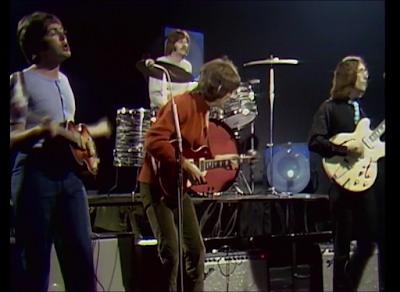
 and the DeLuxe Beatles 1+
and the DeLuxe Beatles 1+ .
.  . So it seems they have honoured his wish. Or perhaps they never had the live vocals taped separately, they may have only been recorded as part of the full mix including the backing track. Back in 1992 when Ron Furmanek remastered and remixed the promo videos for the first time, he also went with mono for "Revolution".
. So it seems they have honoured his wish. Or perhaps they never had the live vocals taped separately, they may have only been recorded as part of the full mix including the backing track. Back in 1992 when Ron Furmanek remastered and remixed the promo videos for the first time, he also went with mono for "Revolution".

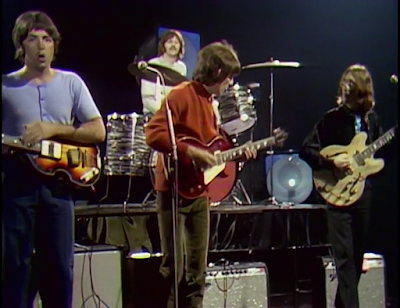
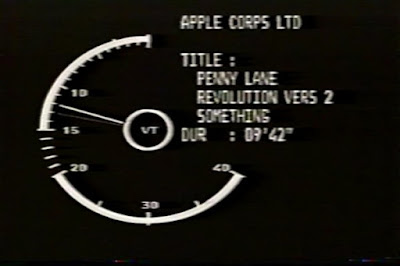




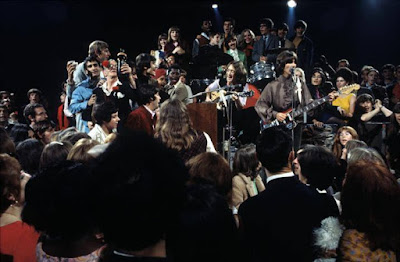


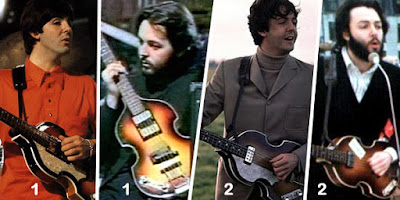








 , this is A Day In The Life as it looks now.
, this is A Day In The Life as it looks now.